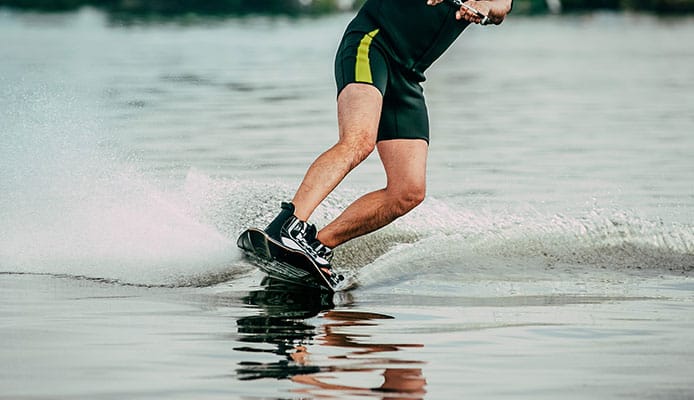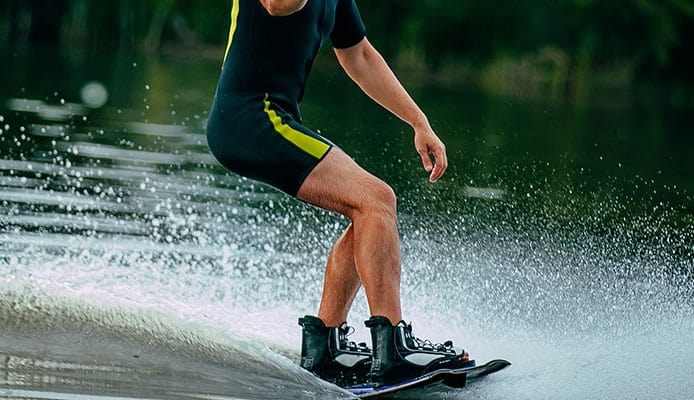
Though both sports take place in water and make use of a boat, wakeboarding and wakeskating do have differences. The major difference, however, is in how the riders are attached to their boards.
While the rider is bound to the board when wakeboarding, wakeskaters are not bound to the board in any way. Though not being bound to the board allows the wakeskaters to do more advanced stunts, it brings some new challenges, including the tendency to fall off the board.
In this wakeboarding vs wakeskating comparison guide, we will take a deeper look at both the similarities and differences existing between the two sports. Outlining both their pros and cons, we will make it much easier for you to choose a sport that suits your style on the water.
Wakeboarding Vs Wakeskating: How do the 2 Sports Differ?
To help you better understand how wakeboarding differs from wakeskating, we will divide this wakeskating vs wakeboarding comparison guide into 2 sections – one covering wakeboarding and the other taking a deeper look at wakeskating:
What’s Wakeboarding?
Wakeboarding involves riding a wakeboard over the water surface with a boat towing you at speeds of between 30 mph and 40 mph. Close-course cable systems, winches, and personal watercraft systems are often used as alternative towing methods.
How Challenging is Wakeboarding?
Wakeboarding is a mix of skateboarding and water skiing. When comparing wakeskating vs wakeboarding in terms of easiness, wakeboarders can control the complexity of wakeboarding – you can make it as challenging or as easy as you wish. With some practice, you should be able to use any wave you catch as a launching pad.
What You Will Need When Wakeboarding
Though very slightly, the wakeboarding vs wakeskating gear varies. To go wakeboarding, you will need:
- A wakeboard
- A rope
- Wakeboard helmet for safety
- A personal floatation device (PFD)
- Some good board shorts
- A rash guard for your upper body.
Towing
It is possible to wakeboard behind almost any boat. However, the best wakeboarding boats are inboard boats. They don’t have outdrives and come with tracking fins. When buying a boat for wakeboarding, you should invest in one that displaces enough water to create a large wave.
Pros and Cons of Wakeboarding
The Pros
- When comparing wakeskating vs wakeboarding safety, wakeboarding takes the win. Since the rider is board bound, the likelihood of crashing is generally lower.
- A boat tows the wakeboarder throughout. Holding the rope gives the rider security.
- Wakeboards are small, making them easy to carry around and store.
The Cons:
- Performing stunts when wakeboarding is harder since the foot is bound to the board – this restricts movement.
You might also like: How To Wakesurf: 10 Beginner Tips And Tricks
What’s Wakeskating?
Wakeskating is much like wakeboarding, but the rider’s feet are not bound to the board in any way. Griptape covers the board’s surface, securing the rider who, in turn, wears shoes to avoid having to fit accessories on the board.
How Does Wakeskating Work?
As an adaptation of wakeboarding, wakeskating employs similar principles applied in wakeboarding, with one major exception – the rider is not bound to the board. The idea of not being bound to the board is similar to how skateboards work, which is where the water sport borrows its name.
Gear Needed When Wakeskating
As noted earlier, the wakeboarding vs wakeskating gear is not entirely similar. Generally, in addition to the gear outlined above for wakeboarding, riders need to wear shoes. When wakeboarding, riders can ride barefoot – this is usually not the case when wakeskating.
It is also worth noting that wakeskaters use the same boards used when wakeboarding. The major difference is that the boat is covered with grip tape or soft, high-traction foam, to make the inevitable crashes much easier on the rider.
Towing
The speed at which wakeskaters ride behind a boat, cable system, or a winch is usually lower than when wakeboarding. While the towing process is similar, the speeds usually range from 16 to 22 mph.
The Pros and Cons of Wakeskating
The Pros:
- Not being bound to the board allows riders to do stunts, making wakeskating more fun.
- Wakeskates are small and light, making their storage, and carrying around easy.
The Cons
- Without board bindings, it is generally easier to fall off the board. This makes wakeskating more demanding when it comes to balancing.
- Crashes are more common when wakeskating than when wakeboarding.
FAQs

Globo Surf Overview
Wakeskating is a sport derived from a combination of skating and wakeboarding, and in practice, it has similarities with skateboarding but on water. Unlike wakeboarding, the rider is not bound to the wakeskating board, which generally brings unique challenges into the sport. In this wakeboarding vs wakeskating guide, we have taken a deeper look at how the two sports compare and contrast.

